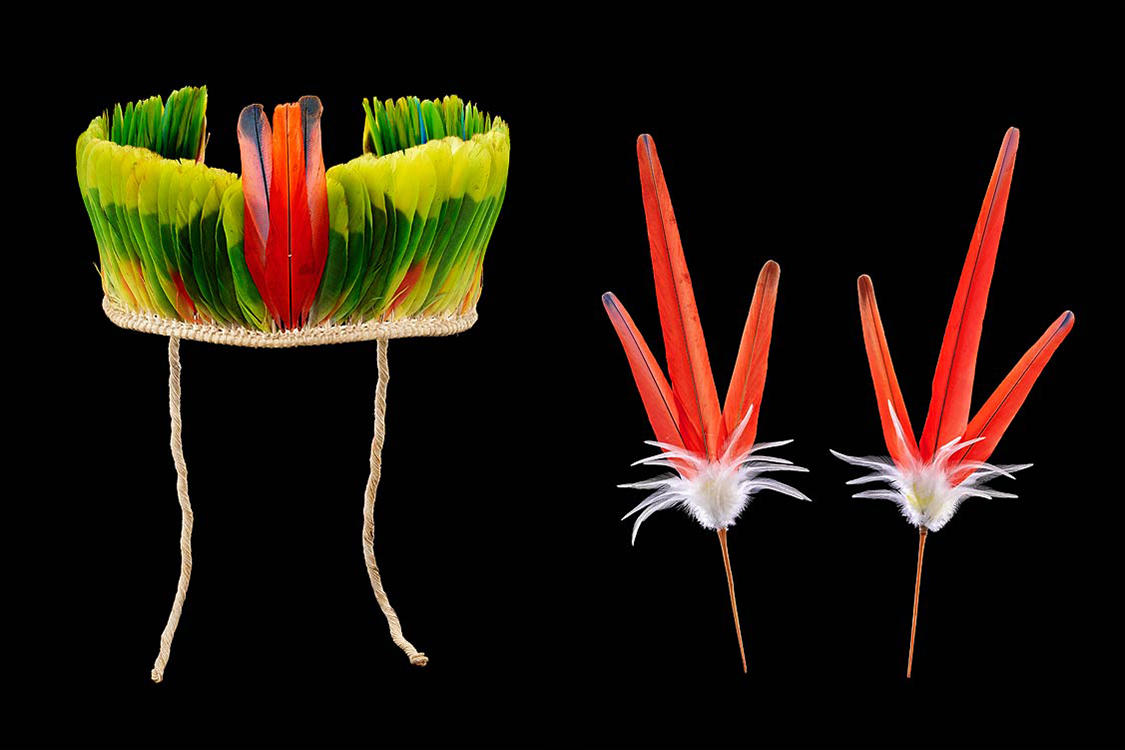
The changing attitude to collecting artefacts

A Geneva museum is showcasing hundreds of items from Amazonian indigenous groups that were amassed by travellers and later gifted to the city. But do works like these belong here or in their country of origin?
Set among the pretend foliage, speckled light and sounds of jungle habitats lie everyday objects and ceremonial items. Recorded monkey screeches, bird squawks and even illegal logging can be heard, reminding visitors of the life and struggles of the Amazonian populations.
This is Amazonia – The Shaman and the Mind of the ForestExternal link, where three centuries’ worth of works are on show, collected by soldiers, botanists, engineers and diplomats who travelled to different parts of the watershed region.
“Most of the objects obtained in the 19th and early 20th centuries were often acquired through exchanges with the populations,” said Geneva’s Ethnographic Museum director Boris Wastiau.
In 1759 Ami Butini, a Genevan plantation proprietor and slave owner in Suriname was one of the first to donate curios from the region to the public library in Geneva.
Oscar Dusendschön, a Brazilian of German origin who owned a rubber business in Manaus, bequeathed around 400 objects at the time of his death to Geneva, where he had retired. Many of these are on display at the new exhibit, such as colourful feather tiaras, axes and a shaman’s rattle.
According to Wastiau – he “most likely obtained” these objects from explorers who visited him in the Brazilian jungle town.
“The first things that were brought over were feather finery… to show what was exotic at the time… always with a Euro-centric, and ethnocentric perspective, to show that those people were savages,” explained archaeologist Leonid Velarde. “Through the type of items they collected – javelins, arrows, harpoons – the collectors were reflecting their views towards the indigenous peoples.”

Objects of importance
In 2014, Switzerland returned a 2000-year-old stone monolith, representing the Illa del Ekeko, or deity of prosperity, to Bolivia. The figure, of important shamanistic significance, was obtained in 1858 by the Swiss explorer Johann Jakob von Tschudi allegedly in exchange for a bottle of cognac. After Tschudi died, his family donated the statue to Bern’s History Museum.
Carine Simoes, deputy head of Switzerland’s Specialised Body for International Transfer of Cultural Property which handles restitution, explained that often requests to return objects are founded on “ethical and deontological” foundations, as opposed to law.
“Most times there is a discussion between the parties to find a solution that is the most fair and equitable. It is rarely based on law for objects which have been exported a long time ago and in particular before 2005, the year of entry into force of the Swiss federal act on the international transfer of cultural property.”
Under Swiss legislationExternal link, cultural property refers to objects “of importance”, which are old and “of ethnological interest.”
Wastiau said national legislation in the countries of origin varied regarding the type of cultural property in question. In the region, legislation had often been drawn up with pre-Columbian objects in mind. “In the case of many South American countries archaeological patrimony legislation has existed since the early 19th century. I don’t think that similar legal protection existed for items that may have been considered as artisanal objects and did not have the same patrimonial value in their countries of origin.”
No disputed items
Velarde, who has collaborated with the museum, explained that while objects were taken from their original owners and indigenous groups with agreements in more recent years, problems may arise more for the earlier pieces, which had been acquired before the beginning of the 20th century.
“It would appear that the objects are clean, but not always. There are pieces that certainly should not have left [their ethnic groups and respective countries], certainly ritual ones.”
The show’s curator Philippe Mathez told swissinfo.ch that there are no ongoing disputes over items in the museum’s collection and any future claims would have to be considered.
While the reasons for collecting have changed since the times of the early collectors whose acquisitions are highlighted at the museum, appreciation of cultural objects by their original owners has also evolved.
Velarde said that before, many indigenous people had “not realised the scope of losing their patrimony . Now there is a growing awareness – which due to technologies, such as the internet – allows it to spread more easily”.
“I think there will be an increasing mindfulness in the coming years to request the return of objects to their countries of origin.”
Many of the early collections of Amazonian objects, some from as early as the 18th century, which are now part of Geneva’s Ethnographic Museum, came to Europe and Geneva, in particular.
Hunting blowpipes, still tipped in poisonous curare, shields, bows and arrows, feathered jewellery and finery and hallucinogenic substances are amongst the nearly 500 items in the show, placed under the Swiss commission for UNESCO.
In one vitrine, a flute, only partially visible through a leafy screen, is exhibited. Traditionally, only certain members of ethnic groups are authorised to view the instrument, which comes from Brazil’s Mato Grosso region.
Curator Philippe Mathez explained that the museum hoped to be sensitive to indigenous rituals and traditions in the presentation of objects, many of which had strong spiritual meanings.
What do you think? Should artefacts like these belong in museums abroad? Tell us in the comments section below.

In compliance with the JTI standards
More: SWI swissinfo.ch certified by the Journalism Trust Initiative




























You can find an overview of ongoing debates with our journalists here . Please join us!
If you want to start a conversation about a topic raised in this article or want to report factual errors, email us at english@swissinfo.ch.